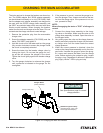
16 ► MBX15 User Manual
Initsmostextreme forms,thecombinationof surface
damageandseverebendingcanquicklybreakeventhe
bestworkingsteels.
Theillustrationsbelowshowexamplesofseverestress
breaks.
Figure15.SevereStressBreaks
PRYING
This is the most common cause of tool failure. Even
whenthereisnosurfacedamage,thestressfrompry-
ingcaneasilybreakaworkingsteel.Thiskindoffailure
generallyresultsfromanytypeofsidepressuresuchas
anincorrectbreakingangleorfromusingthetooltore-
positionmaterial.Thetoolshouldnotbeusedasapivot
pointwhenrepositioningthecarrier.Thepowergener-
atedbythecarrierwillfarexceedthestrengthofthetool.
Figure16.PryingDamageExample
Similarfailurescanalsooccurwhenthesteelisused
with extreme down pressure, and the steel repeated-
lyslipsofftheworkatanangle,orthematerial,itself
movesfromundertheworkingsteel.
Figure17.ExtremeDownPressureBreakage
Asthenextillustrationshows,fatiguefailurestakemany
forms,buttheyallexhibitsimilarfeatures.Generally,the
brokensurfaceisbrittleandhasa“lip”likethatinthe
bendingfailure,eventhough,insomecases,theliphas
beenbroken.
Figure 18. Fatigue Failures
CORROSION
Toolsshouldbegreasedandstoredoutoftheweather.
Corrosiontendstoacceleratethefatiguefracturesofthe
tool.
MUSHROOMING
Drivingthetoolintoahardmaterialforalongperiodof
timegeneratesanintenseheat,indicatedbyabluetone
justabovethepoint.Thiswillsoftenthesteelandcause
thepointtofoldoverormushroomtheendofthetool.
Avoidhammeringinonelocationfortoolong.Ifmaterial
doesnotbreakafterashortperiod(approximately15to
20seconds),repositionthetool.
Figure 19. Mushrooming
If the overheated steel is suddenly cooled by being
dipped in standing water, for example, the metal will
hardenandbecomebrittle.Thesearesomeexamples
offailurecausedbytemperchangesoccurringonthe
job.
PROPER USE & CARE OF TOOL BITS


















